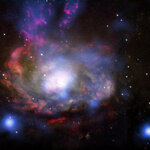Space

Over a decade after it exploded, one of the nearest supernovae in the last 25 years has been identified. This result was made possible by combining data from the vast online archives from many of the world’s premier telescopes.
The supernova, called SN 1996cr, was first singled out in 2001 by Franz Bauer. Bauer noticed a bright, variable source in the Circinus spiral galaxy, using NASA's Chandra X-ray Observatory. Although the source displayed some exceptional properties Bauer and his Penn State colleagues could not identify its nature confidently at the time.
It was not until years later…

Using data from NASA's Wilkinson Microwave Anisotropy Probe (WMAP), scientists have identified an unexpected motion in distant galaxy clusters. The cause, they suggest, is the gravitational attraction of matter that lies beyond the observable universe.
"The clusters show a small but measurable velocity that is independent of the universe's expansion and does not change as distances increase," says lead researcher Alexander Kashlinsky at NASA's Goddard Space Flight Center in Greenbelt, Md. "We never expected to find anything like this."
Kashlinsky calls this collective motion a "dark flow" in…

Two terrestrial planets in orbit around a sun-like star, BD +20 307, recently suffered a violent collision, astronomers at University of California Los Angeles, Tennessee State University, and California Institute of Technology will report in a December issue of the Astrophysical Journal, the premier journal of astronomy and astrophysics.
“It’s as if Earth and Venus collided with each other,” said Benjamin Zuckerman, UCLA professor of physics and astronomy and a co-author on the paper. “Astronomers have never seen anything like this before; apparently major, catastrophic, collisions can take…

Observations from NASA’s Cassini spacecraft have been used to build, for the first time, a 3-D picture of the sources of intense radio emissions in Saturn’s magnetic field, known as the Saturn Kilometric Radiation (SKR).
Saturn Kilometric Radiation is the most intense component of radio emissions from Saturn. It was discovered by NASA’s Voyager spacecraft in 1980. The radio emissions have frequencies between about 10 kilohertz and 1.2 megahertz. This corresponds to the Long Wave and Medium Wave broadcasting bands.
The results were presented by Dr Baptist Cecconi, of LESIA, Observatoire de…

A gamma-ray burst is, in a sense, a look back in time. Scientists have now seen one that happened farther back in time than any other seen before. Even before the existence of the Milky Way.
Gamma-ray bursts (GRBs) are the most powerful and brightest explosions of energy in our universe. They last only a few milliseconds to several minutes and they outshine all other sources of gamma rays combined. Astronomers now think that most GRBs are associated with the explosive deaths of massive stars. These stars collapse and explode when they run out of nuclear fuel.
This image merges the view…

A study has given new insights into why Oval BA, a giant anticyclone on Jupiter also known as Red Spot Junior, suddenly turned from white to red in a period of just a few months.
The Oval BA is an enormous anticyclone (high-pressure system) that may be compared to a colossal hurricane in the Earth’s atmosphere. Oval BA is half the size of the Great Red Spot and is large enough to contain the Earth inside it.
Oval BA was formed in 2000 by the merger of smaller vortices called the White Ovals in a chain of collisions that started back in 1998. The apparent reddening was first reported by…

Precise measurements by the ESO instrument HARPS now show that the rotation of the Milky Way is simpler than previously thought - the much debated, apparent 'fall' of neighborhood Cepheid stars towards our Sun stems from an intrinsic property of the Cepheids themselves, say a group of astrophysicists led by Nicolas Nardetto in a Astronomy & Astrophysics article.
Since Henrietta Leavitt's discovery of their unique properties in 1912, the class of bright, pulsating stars known as Cepheids has been used as a distance indicator. Combined with velocity measurements, the properties of Cepheids…

A group of scientists from Durham University say they have found the "missing link" between small and super-massive black holes. The researchers have discovered that a strong X-ray pulse is emitting from a giant black hole in a galaxy 500 million light years from Earth.
The pulse has been created by gas being sucked by gravity on to the black hole at the centre of the REJ1034+396 galaxy.
X-ray pulses are common among smaller black holes, but the Durham research is the first to identify this activity in a super-massive black hole. Most galaxies, including the Milky Way, are believed to…

An international team of scientists predict that our galaxy, the Milky Way, contains a disk of ‘dark matter’, in a paper published in Monthly Notices of the Royal Astronomical Society.
Astronomers Dr. Justin Read, Professor George Lake and Oscar Agertz of the University of Zurich, and Dr. Victor Debattista of the University of Central Lancashire used the results of a supercomputer simulation to deduce the presence of this disk. They explain how it could allow physicists to directly detect and identify the nature of dark matter for the first time.
Unlike the familiar ‘normal’ matter that makes…

A long-standing scientific belief holds that stars tend to hang out in the same general part of a galaxy where they originally formed. Some astrophysicists have recently questioned whether that is true, and now new simulations show that, at least in galaxies similar to our own Milky Way, stars such as the sun can migrate great distances.
What's more, if our sun has moved far from where it was formed more than 4 billion years ago, that could change the entire notion that there are parts of galaxies – so-called habitable zones – that are more conducive to supporting life than other areas are…